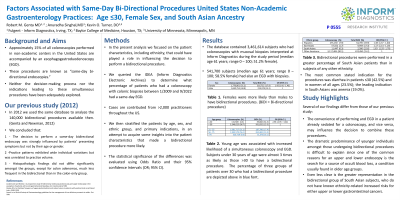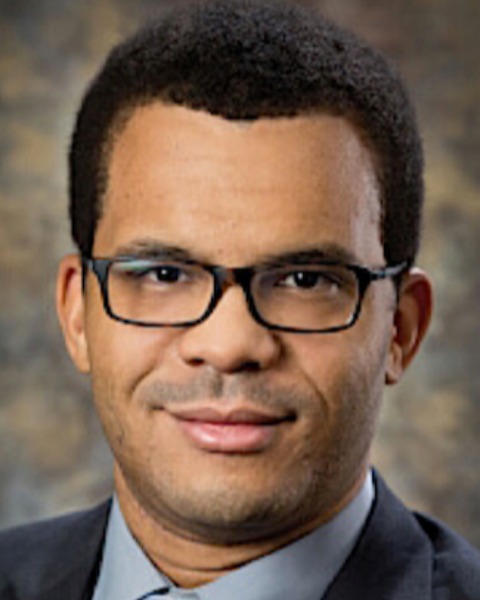Sunday Poster Session
Category: General Endoscopy
P0555 - Factors Associated With Same-Day Bi-Directional Procedures in United States Non-Academic Gastroenterology Practices: Age ≤30, Female Sex, and South Asian Ancestry
Sunday, October 22, 2023
3:30 PM - 7:00 PM PT
Location: Exhibit Hall

Has Audio

Kevin Turner, DO
University of Minnesota
Minneapolis, Minnesota
Presenting Author(s)
Anuradha Singhal, MBBS1, Kevin Turner, DO2, Robert M. Genta, MD3
1Inform Dx - Fulgent, Irving, TX; 2University of Minnesota, Minneapolis, MN; 3Baylor College of Medicine, Irving, TX
Introduction: Approximately 15% of all colonoscopies performed in US non-academic centers are accompanied by an esophagogastroduodenoscopy (EGD). Neither the decision-making process nor the indications leading to these simultaneous procedures have been adequately explored.
Methods: We queried the Inform Diagnostics database to determine the percentage of patients who had a colonoscopy with biopsies between 1/2009 and 9/2022 and a same-day EGD. Cases are contributed from >2,000 practitioners throughout the US. We stratified patients by age, sex, and ethnic group, and primary indications, in an attempt to acquire some insights into the patient characteristics that make a bidirectional procedure more likely. The statistical significance of the differences was evaluated using Odds Ratio and their 95% confidence Intervals (OR; 95% CI).
Results: There were 3,461,614 colonoscopies with mucosal biopsies interpreted at Inform Diagnostics (median age 61 years; range 0 – 100; 51.2% female); 541,700 (median age 61 years; range 0 – 100; 58.5% female) had also an EGD with biopsies; thus, females were more likely to have bidirectional procedures (OR = 1.42 95%CI 1.41 - 1.43; p< .0001). Age was also associated with increased likelihood of a simultaneous colonoscopy and EGD: 15.0% of patients older than 30 years, but 34.5% of patients aged ≤30 years had both procedures (OR = 2.98 95%CI 2.95 – 3.02; p< .0001). Bidirectional procedures were performed in 19.9% of Hispanic patients, in 17.3% of those of East Asian and in 22.6% of South Asian ancestry, compared to 15.2% in all other Americans. The ORs for South Asians vs. other Americans were 1.63 (95% CI 1.55-1.70; p< .0001). The most common stated indication for the procedures was diarrhea in patients ≤30 (42.5%) and in women of all ages (23.5%); the leading indication in South Asians was anemia (19.0%).
Discussion: The convenience of performing an EGD in patients already sedated for colonoscopy, and vice versa, may influence the decision to combine the procedures. However, the dramatic predominance of younger individuals amongst those undergoing bidirectional procedures is difficult to explain since one of the common reasons for an upper and lower endoscopy is reported to be searching for a source of occult blood loss, a condition usually found in older patients. Even less clear is the greater representation in the bidirectional group of South Asian subjects, who do not have known ethnicity-related increased risks for either upper or lower gastrointestinal cancers.
Disclosures:
Anuradha Singhal, MBBS1, Kevin Turner, DO2, Robert M. Genta, MD3. P0555 - Factors Associated With Same-Day Bi-Directional Procedures in United States Non-Academic Gastroenterology Practices: Age ≤30, Female Sex, and South Asian Ancestry, ACG 2023 Annual Scientific Meeting Abstracts. Vancouver, BC, Canada: American College of Gastroenterology.
1Inform Dx - Fulgent, Irving, TX; 2University of Minnesota, Minneapolis, MN; 3Baylor College of Medicine, Irving, TX
Introduction: Approximately 15% of all colonoscopies performed in US non-academic centers are accompanied by an esophagogastroduodenoscopy (EGD). Neither the decision-making process nor the indications leading to these simultaneous procedures have been adequately explored.
Methods: We queried the Inform Diagnostics database to determine the percentage of patients who had a colonoscopy with biopsies between 1/2009 and 9/2022 and a same-day EGD. Cases are contributed from >2,000 practitioners throughout the US. We stratified patients by age, sex, and ethnic group, and primary indications, in an attempt to acquire some insights into the patient characteristics that make a bidirectional procedure more likely. The statistical significance of the differences was evaluated using Odds Ratio and their 95% confidence Intervals (OR; 95% CI).
Results: There were 3,461,614 colonoscopies with mucosal biopsies interpreted at Inform Diagnostics (median age 61 years; range 0 – 100; 51.2% female); 541,700 (median age 61 years; range 0 – 100; 58.5% female) had also an EGD with biopsies; thus, females were more likely to have bidirectional procedures (OR = 1.42 95%CI 1.41 - 1.43; p< .0001). Age was also associated with increased likelihood of a simultaneous colonoscopy and EGD: 15.0% of patients older than 30 years, but 34.5% of patients aged ≤30 years had both procedures (OR = 2.98 95%CI 2.95 – 3.02; p< .0001). Bidirectional procedures were performed in 19.9% of Hispanic patients, in 17.3% of those of East Asian and in 22.6% of South Asian ancestry, compared to 15.2% in all other Americans. The ORs for South Asians vs. other Americans were 1.63 (95% CI 1.55-1.70; p< .0001). The most common stated indication for the procedures was diarrhea in patients ≤30 (42.5%) and in women of all ages (23.5%); the leading indication in South Asians was anemia (19.0%).
Discussion: The convenience of performing an EGD in patients already sedated for colonoscopy, and vice versa, may influence the decision to combine the procedures. However, the dramatic predominance of younger individuals amongst those undergoing bidirectional procedures is difficult to explain since one of the common reasons for an upper and lower endoscopy is reported to be searching for a source of occult blood loss, a condition usually found in older patients. Even less clear is the greater representation in the bidirectional group of South Asian subjects, who do not have known ethnicity-related increased risks for either upper or lower gastrointestinal cancers.
Disclosures:
Anuradha Singhal indicated no relevant financial relationships.
Kevin Turner indicated no relevant financial relationships.
Robert Genta indicated no relevant financial relationships.
Anuradha Singhal, MBBS1, Kevin Turner, DO2, Robert M. Genta, MD3. P0555 - Factors Associated With Same-Day Bi-Directional Procedures in United States Non-Academic Gastroenterology Practices: Age ≤30, Female Sex, and South Asian Ancestry, ACG 2023 Annual Scientific Meeting Abstracts. Vancouver, BC, Canada: American College of Gastroenterology.
